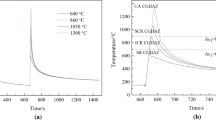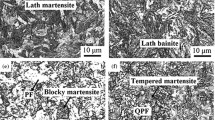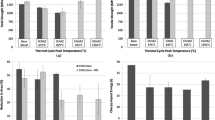Abstract
BlastAlloy 160 (BA160) is a low-carbon martensitic steel strengthened by copper and M2C precipitates. Heat-affected zone (HAZ) microstructure evaluation of BA160 exhibited softening in samples subjected to the coarse-grained HAZ thermal simulations of this steel. This softening is partially attributed to dissolution of copper precipitates and metal carbides. After subjecting these coarse-grained HAZs to a second weld thermal cycle below the A c1 temperature (at which austenite begins to form on heating), recovery of strength was observed. Atom-probe tomography and microhardness analyses correlated this strength recovery to re-precipitation of copper precipitates and metal carbides. A continuum model is proposed to rationalize strengthening and softening in the HAZ regions of BlastAlloy 160.








Similar content being viewed by others
Notes
GLEEBLE is a trademark of Dynamic Systems Inc., Poestenkill, NY.
LECO is a trademark of LECO Corporation, St. Joseph, MI.
LEAP and Cameca are trademarks of CAMECA Instruments, Inc., Madison, WI.
IVAS is a trademark of CAMECA Instruments, Inc., Madison, WI.
PHILIPS is a trademark of FEI Company, Hillsboro, OR.
OIM is a trademark of EDAX, Mahwah, NJ.
There is a typographical error in Ref. 5 regarding to slip plane length of coarse-grained HAZ. In this article it is reported as 2.53 μm. The correct slip plane length for coarse-grained HAZ is 25.3 μm.
THERMO-CALC is a trademark of Thermo-Calc, Stockholm.
References
A. Saha and G.B. Olson: J. Comput. Aided Mater. Des., 2007, vol. 14, pp. 177–200.
A. Saha and G.B. Olson: J. Comput. Aided Mater. Des., 2007, vol. 14, pp. 201–33.
E.J. Czyryca, D.P. Kihl, and R. DeNale: AMPTIAC Q., 2003, vol. 7 (3), pp. 63–70.
R.D. Campbell and D.W. Walsh: ASM Handbook, ASM, Material Park, OH, 1993, vol. 6, pp. 603–13.
C. Jeremy: Ph.D. Thesis, The Ohio State University, Columbus, OH, 2010.
X. Yu, J.L. Caron, S.S. Babu, J.C. Lippold, D. Isheim, and D.N. Seidman: Acta Mater., 2010, vol. 58, pp. 5596–5609.
ASTM E-384-08, ASTM, Philadelphia, PA, 2008.
M.K. Miller: Atom Probe Tomography, Kluwer Academic/Plenum Publishers, New York, NY, 2000.
D. Isheim, R.P. Kolli, M.E. Fine, and D.N. Seidman: Scripta Mater., 2006, vol. 55, pp. 35–40.
R.P. Kolli, R.M. Wojes, S. Zaucha, and D.N. Seidman: Int. J. Mater. Res., 2008, vol. 99, pp. 513–27.
R.P. Kolli and D.N. Seidman: Acta Mater., 2008, vol. 56, pp. 2073–88.
R.P. Kolli and D.N. Seidman: Microsc. Microanal., 2007, vol. 13, pp. 272–84.
O.C. Hellman, J.A. Vandenbroucke, J. Rusing, D. Isheim, and D.N. Seidman: Microsc. Microanal., 2000, vol. 6, pp. 437–44.
M. Mulholland and D.N. Seidman: Scripta Mater., 2009, vol. 60, pp. 992–95.
J.O. Andersson et al.: CALPHAD, 2002, vol. 26, pp. 273–312.
C.B. Fuller, D.N. Seidman, and D.C. Dunand: Acta Mater., 2003, vol. 51, p. 4803–14.
D.N. Seidman, E.A. Marquis, and D.C. Dunand: Acta Mater., 2002, vol. 50, pp. 4021–35.
J.H. Beatty and G.J. Shiflet: Metall. Trans. A, 1988, vol. 19A, pp. 1617–20.
R. Monzen, M.L. Jenkins, and A.P. Sutton: Philos. Mag. A, 2000, vol. 80, pp. 711–23.
N. Maruyama, M. Sugiyama, T. Hara, and H. Tamehiro: JIM, 1999, vol. 40, pp. 268–77.
D. Isheim, M.E. Fine, and D.N. Seidman: Microsc. Microanal., 2007, vol. 13, pp. 1624–25.
S. Morito and T. Ohba: Proc. 1st Int. Symp. on Steel Sci., 2007, pp. 57–62
J. Syarif, T. Tsuchiyama, and S. Takaki: ISIJ Int., 2003, vol. 7, pp. 1100–04.
A. Thorvaldsen: Acta Mater., 1997, vol. 45, pp. 595–600.
J.P. Naylor: Metall. Trans. A, 1979, vol. 10A, pp. 861–73.
S. Morito, H. Yoshida, T. Maki, and X. Huang: Mater. Sci. Eng. A, 2006, vols. 438–440, pp. 237–40.
E. Nembach: Particle Strengthening of Metals and Alloys, John Wiley & Sons, New York, NY, 1997.
A.S. Argon: Strengthening Mechanisms in Crystal Plasticity, Oxford University Press, New York, NY, 2008.
M.E. Fine and D. Isheim: Scripta Mater., 2005, vol. 53, pp. 115–18.
J.Z. Liu, A. Van de Walle, G. Ghosh, and M. Asta: Phys. Rev. B, 2005, vol. 72, p. 144109.
K.C. Russell and L.M. Brown: Acta Metall., 1972, vol. 20, pp. 969–74.
P.J. Craievich, N. Weinert, J.M. Sanchez, and R.E. Watson: Phys. Rev. Lett., 1994, vol. 72, pp. 3076–79.
L.G. Wang, M. Sob, and Z. Zhang: J. Phys. Chem. Solids, 2003, vol. 64, pp. 863–72.
T. Harry and D.J. Bacon: Acta Mater., 2002, vol. 50, pp. 195–208.
S.S. Babu: Int. Mater. Rev., 2009, vol. 54, pp. 333–36.
Acknowledgments
We acknowledge financial support from the Office of Naval Research, Drs. J. Christodoulou and W. Mullins, grant monitors. Atom-probe tomographic measurements were performed at the Northwestern University Center for Atom-Probe Tomography (NUCAPT). The authors also thank Professor G. Olson, Northwestern University, for providing the samples. The LEAP tomograph was purchased and upgraded with funding from NSF-MRI (Grant No. DMR-0420532) and ONR-DURIP (Grant Nos. N00014-0400798, N00014-0610539, and N00014-0910781).
Author information
Authors and Affiliations
Corresponding author
Additional information
Manuscript submitted November 22, 2010.
Appendix
Appendix
1.1 Modeling of Strengthening Mechanisms
For martensitic strengthening, the yield stress of the lath martensite is calculated by summing the contributions from different hardening mechanisms:[22]
where σ 0 is the friction stress to move dislocations for pure Fe, σ s is the yield strength increment due to solid-solution hardening, σ ρ is the strengthening term due to the forest dislocation density, σ g is for grain-boundary strengthening, and σ p is for precipitate strengthening. For the four mechanisms, Cu is the major element varied in the matrix. According to Reference 23, the yield strength increment due to 1 wt pct Cu in solid solution is <50 MPa. Additionally, the dislocation density is a function of M s and the variation of M s in different HAZ regions is small.[6] On the other hand, the strengthening contribution on yield strength from Cu precipitates and martensite block and packet boundaries could be several hundred mega-Pascals.[1,22] As a result, in the present study, only precipitation and grain boundary strengthening are considered in the overall strengthening.
1.2 Martensite Matrix Strengthening
The packet size and block width in the different regions of the HAZ were measured from the EBSD maps using the mean linear-intercept method.[24] Most researchers take the contributions from block width and packet size into account separately when considering grain boundary strengthening.[25,26] The two important parameters, packet size and block width, describe the morphology of lath martensite. Since packet and block boundaries are high-angle boundaries (>15 deg), they should be considered together for grain boundary strengthening. Since the block boundaries inside a packet act as obstacles to dislocation motion, the slip plane length can be described to a certain degree by block width and packet size, which is elaborated in the following content. Assuming that the block morphology is rectangular and the length of the block is equivalent to the packet size, the average slip plane length, M, can be calculated from the block width, d b , and packet size, d p :[25]
From the calculated average slip-plane length, the strengthening introduced by block boundaries can be calculated from the Hall–Petch equation:
where K y is 0.363 MPa m1/2.[25]
1.3 Copper Precipitation Strengthening
Precipitate shearing and precipitate bypass by dislocation looping are two mechanisms generally used to explain precipitate strengthening.[27,28] Bcc Cu precipitates in martensite matrix are considered as weak precipitates.[31] The strength contributions arising from Cu precipitation are difficult to model. Many factors, such as misfit strengthening, chemical strengthening, modulus difference strengthening, and dislocation core-precipitate interaction strengthening contribute to the overall Cu precipitate strengthening in steels.[29] The incorrect equation used to describe modulus difference strengthening by Fine and Isheim[29] has been pointed out by Liu et al.[30] Since modulus strengthening based upon the model of Russell and Brown[31] plays the most important role among all the factors, the current focus is on evaluating the component of Cu precipitation strengthening provided by modulus strengthening. The Russell–Brown model assumes that the modulus strengthening effect is due to the relative difference in dislocation energy between the matrix and Cu precipitates as a result of the modulus difference, as a dislocation passes from the matrix through the Cu precipitate and back into the matrix. The critical shear stress increase caused by the Cu precipitates can be expressed as
where G is the shear modulus in the matrix, taken to be 77 GPa; L is the interprecipitate spacing; b is the Burger’s vector of dislocation, which is 0.25 nm; E P is the dislocation energy in the precipitate; and E M is the dislocation energy per unit length in the matrix. The term \( E_{P}^{\infty } \) is the dislocation energy per unit length in the precipitate; \( E_{M}^{\infty } \) is the dislocation energy per unit length in the matrix; r is the average radius of the precipitates; r 0 is the inner cut-off radius, 0.7 nm; and R is the outer cut-off radius, 1000 r 0. It is assumed that the shear modulus for bcc Cu in the Fe matrix is equivalent to the shear modulus for fcc Cu. For a screw dislocation, the estimated dislocation energy ratio per unit length in an infinite media, \( E_{P}^{\infty } /E_{M}^{\infty } , \) is equal to the shear modulus ratio (G p /G m ). This study used the bulk shear modulus ratio of fcc Cu and bcc Fe, which is 0.6 in the calculation. Substituting the precipitate properties obtained from the atom- probe tomographic analysis into the modulus difference (Eq. [A4]), an estimate of the Cu precipitate strengthening can be provided. It is realized that the Russell–Brown strengthening model is very sensitive to the modulus difference. The measurement of the bcc Cu shear modulus is complicated, since bcc Cu in the α-Fe matrix is metastable and the lattice parameter of bcc Cu is very close to that of bcc Fe. First-principle calculations predicted that the tetragonal shear modulus for bcc Cu could be negative[30,32,33] Liu et al. predictions depended on Fe concentration in the precipitate; the shear modulus of bcc Cu varies from 80 GPa to –20 GPa. If the shear modulus of bcc Cu is positive, the Russell–Brown modulus-mismatch hardening model could be used as a good estimate for bcc Cu precipitate strengthening. Harry and Bacon[34] proposed an alternative strengthening mechanism. When the unstable bcc Cu precipitate is sheared by a dislocation, the bcc Cu lattice may transform to a close-packed structure. During shearing, strength is increased by the structural-transformation mechanism. This mechanism may be considered for the conditions, which leads to a negative shear modulus of bcc Cu. Since the shear modulus of bcc Cu and the strengthening mechanism are still being debated, this study applies the classic Russell–Brown model and the parameters to estimate the strengthening by Cu precipitates. We note that the model could be improved if an accurate bcc Cu shear modulus and effective interprecipitate distance could be estimated. This will require in-situ measurement of the Cu precipitate modulus using in-situ diffraction techniques.[35]
Rights and permissions
About this article
Cite this article
Yu, X., Caron, J.L., Babu, S.S. et al. Strength Recovery in a High-Strength Steel During Multiple Weld Thermal Simulations. Metall Mater Trans A 42, 3669–3679 (2011). https://doi.org/10.1007/s11661-011-0707-y
Published:
Issue Date:
DOI: https://doi.org/10.1007/s11661-011-0707-y




